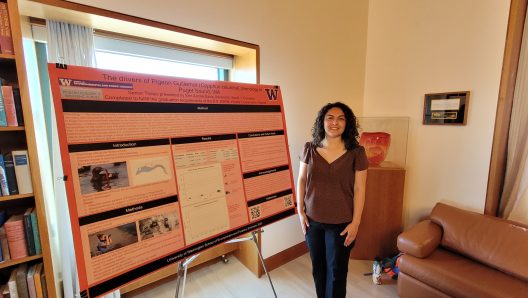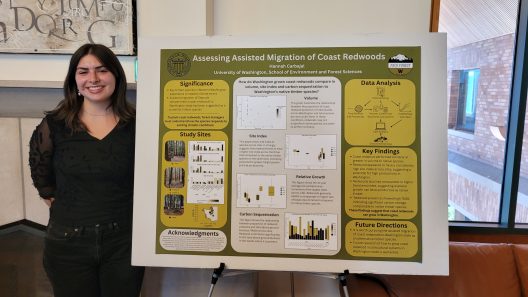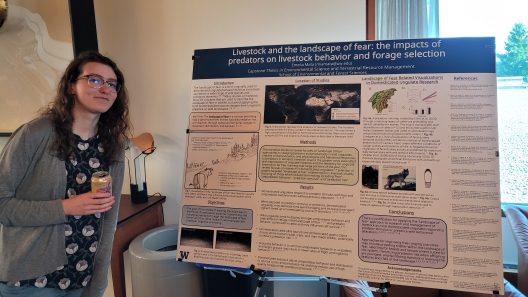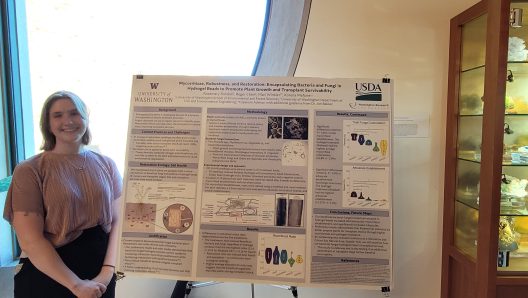Event Recap – 2025 Spring Capstone Poster Session
Last week 13 students who have been working closely with faculty presented their work during a poster presentation session in Allen Library. Meet some of this Spring’s capstone students and learn more about the environmental research happening here at SEFS!
Erin Arzola-Davis | Wildlife Conservation
Advisor | S. Converse
Capstone Topic | The drivers of Pigeon Guillemot (Cepphus columba) phenology in Puget Sound, WA
Phenology — the timing of life history events in nature such as reproduction — is crucial in determining reproductive success for many taxa. This timing is flexible to changes in environmental cues, especially for migratory birds. Pigeon guillemots (Cepphus columba) are an important bioindicator species in Puget Sound, WA. Using a 10 year count data series of breeding guillemots in Puget Sound, I explored the relationship between observed changes of reproductive phenology and various environmental factors in Puget Sound.
Hannah Carbajal | Sustainable Forest Management
Advisor | G. Ettl
Capstone Topic | Assessing Assisted Migration of Coastal Redwoods in Washington
As key timber species in Western Washington experience increased climate stress, the assisted migration of Sequoia sempervirens has been suggested to sustain working forests and conserve the redwood species.
Iris Dimpsey
Advisor | L. Prugh
Capstone Topic | Parasites in the City: Examining the Impact of Urbanization on Coyote Health
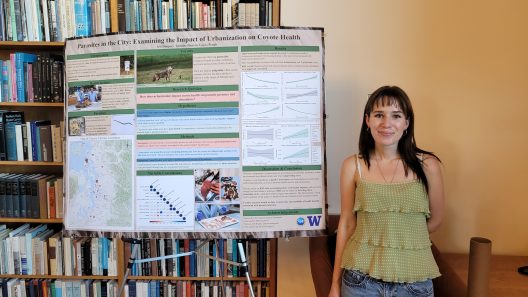 Coyotes (Canis latrans) have adapted to life in urban environments, but these shifts may influence their health through altered parasite prevalence and infection intensity. My Capstone examines the associations between intestinal parasite prevalence and coyote physiological health across an urban-to-rural gradient in the Seattle-Tacoma area.
Coyotes (Canis latrans) have adapted to life in urban environments, but these shifts may influence their health through altered parasite prevalence and infection intensity. My Capstone examines the associations between intestinal parasite prevalence and coyote physiological health across an urban-to-rural gradient in the Seattle-Tacoma area.
Katharine Gilliam
Advisor | P. Tobin
Capstone Topic | Spongy Moth Outbreak Effects on Tree Growth Suppression in Northeastern Wisconsin: A Dendrochronological Analysis
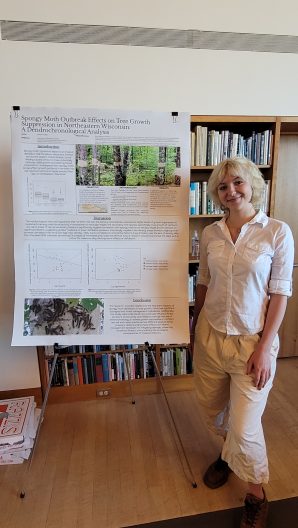
The purpose of this research is to investigate the effect of foliage-feeding by the spongy moth on northern red oak and maple tree growth across different larval densities. The study area and time period includes tree growth patterns prior to, during, and after a spongy moth outbreak. This study will explore how larval density and host species affect tree growth by assessing correlations in tree-ring patterns through dendrochronology and statistical analysis.
Liza Kovich in partnership with Anna Kresler, Zoe Russom, Brady Imperial, Simon Edgecumbe, Clara Soltys
Advisor | C. Updegrave
Capstone Topic | Green Lake South Willows Wetland Habitat Restoration
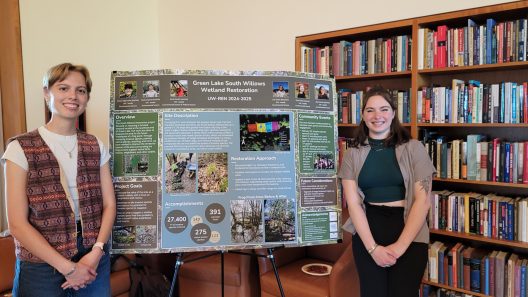
Our project focused on restoring a forested wetland at Green Lake to prepare the area for a future frog pond. We have been enhancing terrestrial habitat to support native populations of birds, insects, and amphibians by planting native plants, removing invasive species, mulching, and more.
Emelia Mata
Advisor | A. McInturff
capstone Topic | Livestock and the Landscape of Fear: the Impacts of Large Predators on Livestock Movements and Forage Selection
Lark Murphy | Sustainable Forest Management
Advisor | E. Alvarado
Capstone Topic | Fire Management Forest Plan for Colville Reservation
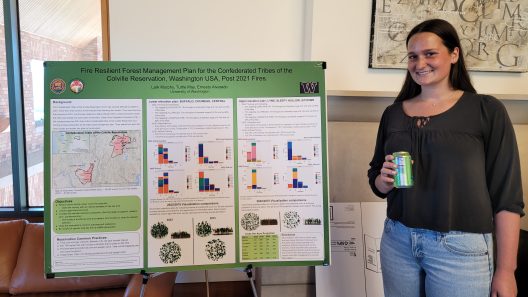
Used ArcGIS data and FVS to come up with a long term forest prescription plan for the Colville Reservation. The prescription’s goal is for post fire management after two large fires in 2022 with the main objective to build forest fire resilience.
Rosemary Randall | Restoration Ecology & Environmental Horticulture
Advisor | M. Winkler
Capstone Topic | Mycorrhizae, Robustness, and Restoration: Encapsulating Bacteria and Fungi in Hydrogel Beads to Promote Plant Growth and Establishment in Restoration Practices
Emily Reeves
Advisor | P. Tobin
Capstone Topic | Role of Climate in Host Plant Tolerance to White Pine Blister Rust
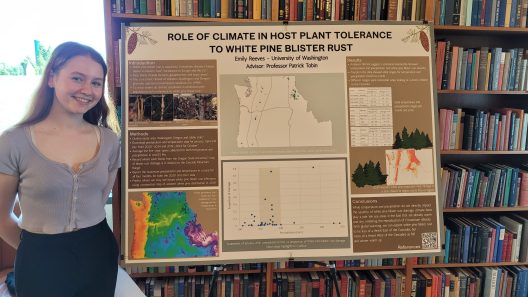
Effects of precipitation and temperature variation on levels of white pine blister rust damage severity.
Bre Rodriguez Vega
Advisor | S. Kim
Capstone Topic | Exploring the Effects of Light Spectrum on Monstera deliciosa Leaf Morphology
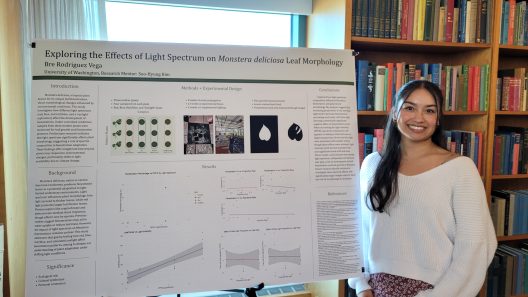
Monstera deliciosa, known for its fenestrated leaves, is a popular houseplant native to tropical environments. While light availability has been linked to fenestration development, the effects of specific light spectrums remain unclear. This study examines how red, blue, and red/blue light affect leaf morphology, using controlled lighting and a sunlight-replicated control. Leaf area and fenestrations are measured weekly across three mother plants and their samples. Findings could indicate that light spectrum significantly influences leaf structure, offering insight into plant adaptation and contributing to the understanding of tropical plant responses to environmental changes.
Miranda Schmidt | Wildlife Conservation
Advisor | J. Lawler
Capstone Topic | Evaluating Habitat Restoration Strategies for Taylor’s Checkerspot through Population Dynamics
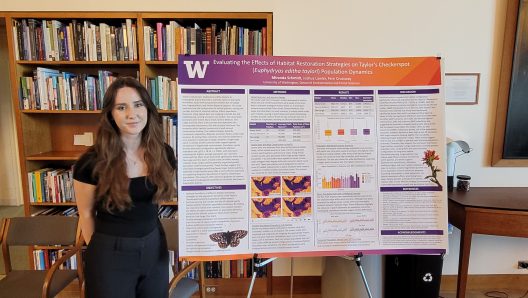
Taylor’s Checkerspot, an endangered butterfly native to the Pacific Northwest, is threatened by habitat loss and fragmentation. This project uses GIS mapping and simulation modeling to test different habitat restoration strategies, exploring the effects of patch size and quantity. By modeling a set of representative restoration approaches, we aim to identify the best strategies to promote long-term survival. The results will guide practical conservation efforts to restore prairie ecosystems and support endangered species recovery.
Carol Wang | Wildlife Conservation
Advisor | A. Wirsing
Capstone Topic | Deer anti-predator behavior in managed landscape in Eastern Washington
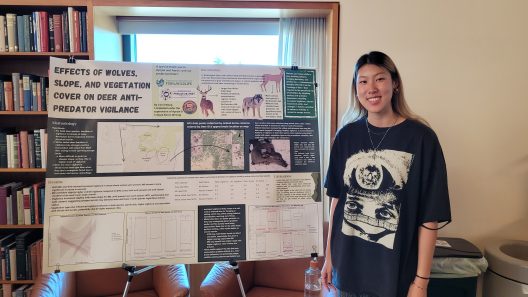
This project is a sub-study of Apryle Craig’s research on collared deer in the Okanogan region of Eastern Washington. I analyzed data collected by her lab to examine whether the time deer spent foraging, being vigilant, or bedding was associated with terrain slope and vegetation cover type.
